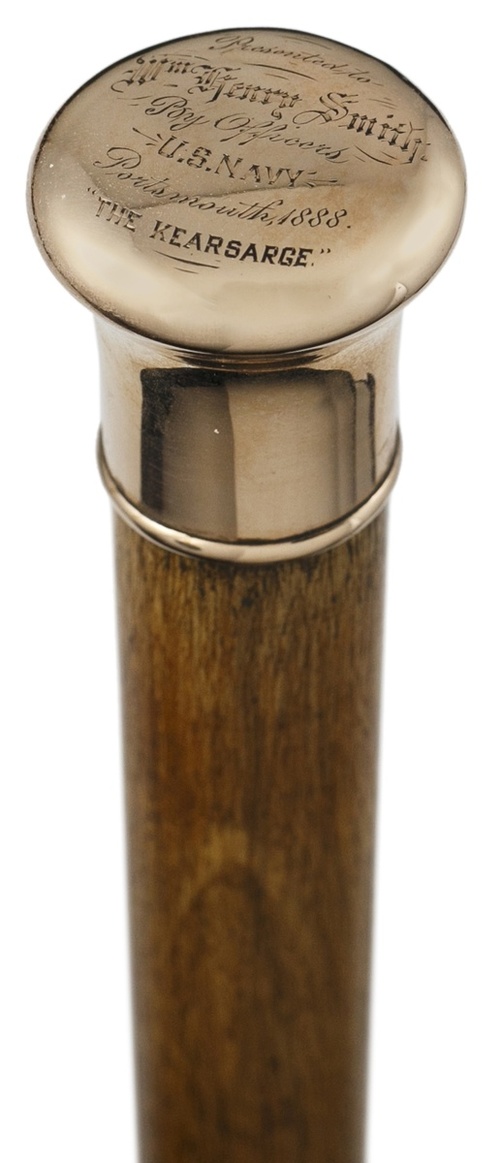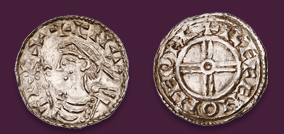Auction: 394 - Coins, Commemorative Medals, Autographs and Documents - e-Auction
Lot: 717
Gold-handled Walking Stick Presented to Master's Mate William Henry Smith, Congressional Medal of Honor winner, U.S.S. Kearsarge, U.S. Navy, on the Occasion of his Retirement in 1888.
32 1/3" tapering straight grained hickory stick; domed rose gold handle and sheath, 1 ¾", with replacement brass-mounted steel ferrule. The handle not hallmarked, but tested. Handle ornately engraved: "Presented to Wm Henry Smith by Officers U.S. NAVY Portsmouth 1888 THE KEARSARGE"
Born in Providence, Rhode Island, in 1826, Master's Mate William Henry Smith served in the United States Navy for over 25 years, exclusively aboard the USS Kearsarge, 1862-1888. Enlisting as a Seaman at New Bedford, January 7, 1862, he was promoted Coxswain, July 4 1862, and saw service aboard the Kearsarge during the action with the Confederate raider C.S.S. Alabama on 19th June 1864 as Second Quartermaster and Acting Captain of the crew of the ship's 11 inch aft pivot gun. Following the action, Smith was promoted Master's Mate, and was still serving as Master's Mate aboard the Kearsarge at the time of his retirement from the U.S. Navy at Portsmouth, New Hampshire, in 1888, when this walking stick was presented to him by the officers of the Kearsarge. After his discharge from the navy, Smith disappeared into obscurity, and nothing is apparently known of his later life and whereabouts.
Smith was one of 17 men from the U.S.S. Kearsarge awarded the Congressional Medal of Honor for gallantry during the action with the C.S.S. Alabama. Smith's citation, dated Dec. 31, 1864, based on the testimony of Confederate officers serving on the Alabama at the time of its sinking, confirms that the gun that Smith commanded during the action was the one principally responsible for the sinking of the Confederate ship, and reads as follows: "Served as Second Quartermaster on board the U.S.S. Kearsarge when she destroyed the Alabama off Cherbourg, France, 19 June 1864. Acting as Captain of the 11 inch pivot gun of the second division, Smith carried out his duties courageously and deserved special notice for the deliberate and cool manner in which he acted throughout the bitter engagement. It is stated by rebel officers that his gun was more destructive and did more damage than any other gun of the Kearsarge." The firing from Smith's gun was so accurate and destructive that, during the action, the Alabama's commanding officer ordered all of his ship's guns to concentrate their fire on Smith's gun and its crew. Despite the intensity of the incoming fire, Smith and his gun crew remained at their positions and continued to return fire accurately, and were responsible for firing the round that holed the Alabama below the waterline and sank her. During the action, three men from Smith's gun crew were wounded, one of them mortally.
The U.S.S. Kearsarge, a screw sloop-of-war, left Portsmouth, New Hampshire, with Smith aboard, on Feb. 5, 1862, for Gibraltar, where she took part in the blockade of the Confederate raider C.S.S. Sumter, forcing the latter ship's abandonment. The Kearsarge then set about hunting down the Alabama, ranging all along Europe's west coast, from the Canaries and Madeira in the south to as far north as the Outer Hebrides. On June 14, 1864, the Kearsarge arrived off Cherbourg, where the Alabama was in port undergoing repairs. The captain of the Kearsarge, John Ancrum Winslow, telegraphed Gibraltar requesting that the sloop-of-war U.S.S. St. Louis join him in the blockade of the Alabama. Boxed in, the Alabama's captain concluded that the only escape was to fight his way out. The ship left Cherbourg June 19 and immediately engaged the Kearsarge. Her gunners ignoring the incoming fire, the Kearsarge did not open fire until the enemy was within 1,000 yards range. The ensuing battle quickly went against the Confederate ship as a result of the superior, disciplined gunnery of the Kearsarge, which was largely protected from enemy fire by chain armor. Within an hour of the first shot being fired the Alabama was reduced to a sinking wreck. Although the Kearsarge sent boats to rescue the crew of the Alabama, her captain and 40 of its officers and men evaded capture by their would-be rescuers, instead boarding the British steam yacht Deerhound, which transported them to England.
Henry Smith spent the remainder of the civil war aboard the Kearsarge hunting down Confederate raiders, at first sailing along the French coast in an unsuccessful search for commerce raider C.S.S. Florida. After refitting and repairs in Boston, the Kearsarge sailed for Spain April 14, 1865 with orders to intercept the Confederate ram, C.S.S. Stonewall, but the Stonewall successfully evaded her and instead surrendered to the Spanish authorities. Following the end of the Civil War Smith saw extensive service aboard the ship in the Pacific, venturing as far afield as Chile, Peru, the Marquesas, Society Islands, Navigators Islands, the Fiji Islands, New Zealand, the Hawaiian islands, China and Japan.
At the time of the celebrated action, there was another seaman named William Smith serving aboard the Kearsarge: First Class Fireman William Smith. This has unfortunately, and no doubt resulting from the disappearance from history after 1888 of Master's Mate William Henry Smith, since then led to considerable confusion with regard to the two men, even to the extent that an official Congressional Medal of Honor Recipient's grave marker was placed on Fireman William Smith's grave in error after his death in 1902. This other William Smith was born in Ballymena, Co. Antrim, Ireland, May 5, 1838. He enlisted into the U.S. Navy as a 1st Class Fireman on Nov. 28, 1862, was discharged in 1865, shortly after the Civil War ended and died at Concord, New Hampshire, on Jan. 12, 1902. The erroneous placing of an official Medal of Honor grave marker on his grave after his death, led to much bewilderment amongst researchers. However, the service details of the two men and the inscription on the handle of the walking stick confirm that it was presented to the Congressional Medal of Honor winner, Masters Mate William Henry Smith, when he retired from the US Navy in 1888, not the Fireman William Smith, who was discharged in 1865.
This stick was broken at some stage during its working life and the end section, including its ferrule, lost, but it has now been professionally restored and re-finished with a replacement brass mounted steel ferrule. The gold handle is lightly worn from use, but the engraved inscription clearly legible.
Estimate
$1,500 to $2,000
Starting price
$1200







